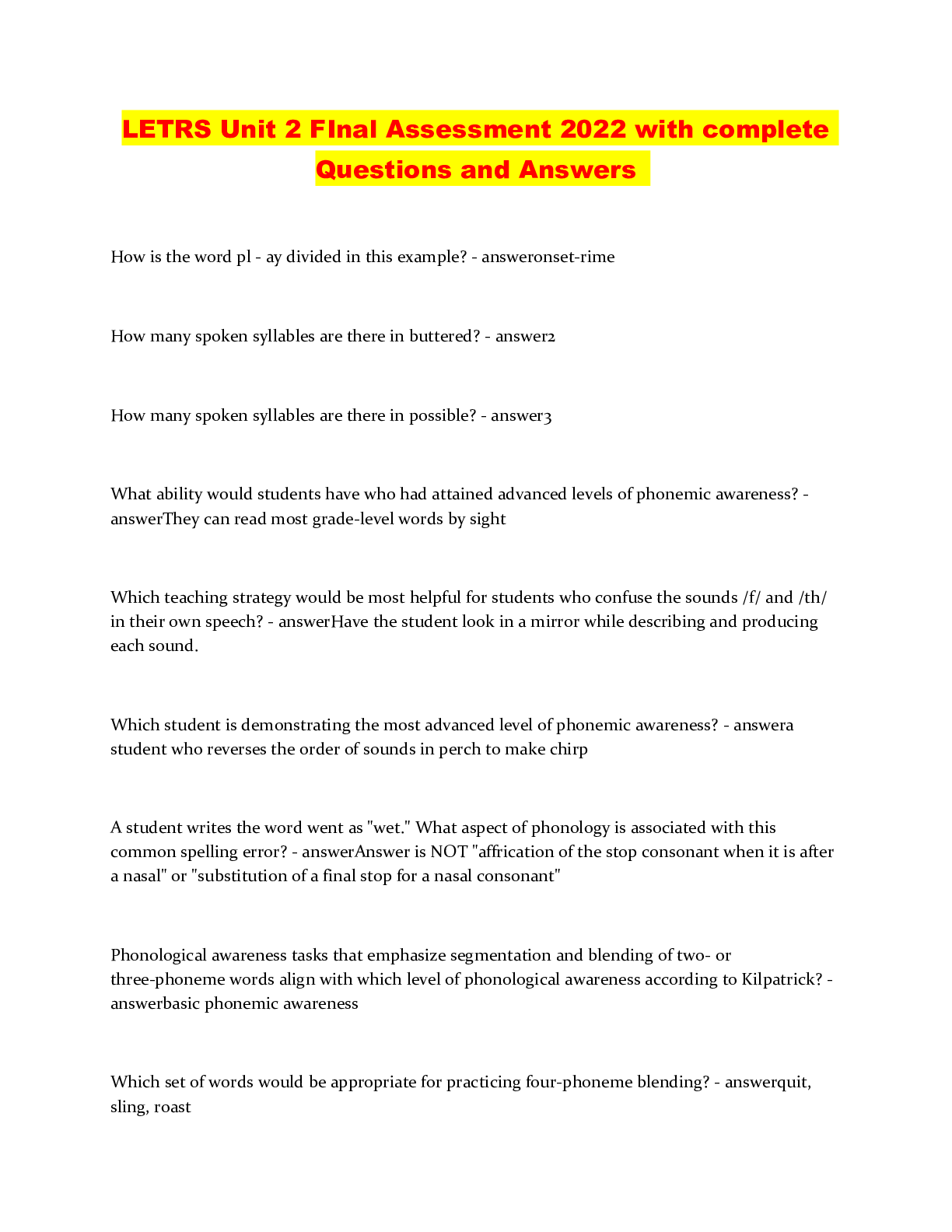Marketing > QUESTIONS & ANSWERS > Chapter 17—Measuring Ad Message Effectiveness. All Answers (All)
Chapter 17—Measuring Ad Message Effectiveness. All Answers
Document Content and Description Below
TRUE/FALSE 1. Watchable ads often include continuous voiceovers. F PTS: 1 2. The demand for accountability that is prevalent throughout business necessitates that ads be tested before they... are placed in media and then again during or after the period in which they have been printed or broadcast. T PTS: 1 3. Measuring message effectiveness is not a difficult or expensive task. F PTS: 1 4. The two general forms of advertising research that are practiced are message research and focused research. F PTS: 1 5. Positioning Advertising Copytesting (PACT) was formulated by Proctor & Gamble to remedy the problem of mediocre or flawed advertising research. F PTS: 1 6. A good copytesting system is one that requires agreement about how the results will be used in advance of each specific test. T PTS: 1 7. A good copytesting system provides a single measurement to assess the performance of an advertisement. F PTS: 1 8. There is a single advertising-effectiveness measurement technique that is ideal and appropriate for all occasions. F PTS: 1 9. Message research comes in two general forms: qualitative and quantitative. T PTS: 1 10. Quantitative research is concerned with generating insights into and interpretations of those advertising elements that influence people’s responses to advertisements, and focus groups represent a major form of quantitative ad research. F PTS: 1 11. Recognition taps a more superficial level of memory compared to recall measures. T PTS: 1 12. Starch measures the primary objective of a television advertisement. F PTS: 1 13. Gfk MRI’s Starch Ad Readership Studies interviews respondents and then classifies them as noted, associated, read-some, or read-most readers according to specific definitions. T PTS: 1 14. The "Read Most" classification of the Gfk MRI’s Starch Ad Readership Studies is the percentage of people interviewed who read 80 percent or more of the written material in the advertisement. F PTS: 1 15. An advertisement that achieves a Starch score of 70 indicates it scored 70 percent above comparable ads. F PTS: 1 16. A basic assumption of the Starch procedure is that respondents in fact do remember whether they saw a particular ad in a specific magazine issue. T PTS: 1 17. The Bruzzone Research Company provides advertisers with a test of consumer recognition of radio advertisements. F PTS: 1 18. Bruzzone testing provides a valid prediction of actual marketplace performance along with being relatively inexpensive compared with other copytesting methods. T PTS: 1 19. Gallup & Robinson provides recall testing of advertisements placed in televised media. F PTS: 1 20. Physiological measures such as galvanic skin response and pupil dilation are used to assess physiological arousal activated by advertisements. T PTS: 1 21. There is evidence to indicate that galvanic skin response is a valid indicator of the amount of warmth generated by an advertisement. T PTS: 1 22. In pupillometric tests, greater dilation means a more favorable response to the message. T PTS: 1 23. The Next*TV method tests television commercials in consumers’ homes. T PTS: 1 24. The ComScore ARS’ Share of Choice method only tests television commercials in finished form. F PTS: 1 25. ComScore ARS’ Share of Choice scores of 2.0 or lower are defined as inelastic, implying that commercials scoring this poorly are probably incapable of driving market-share gains. T PTS: 1 26. Single source systems are advertising research services that measure consumer recall of advertisements placed in all major media. F PTS: 1 27. Nielsen is an advertising research company that helped develop the ScanTrack single-source system. T PTS: 1 28. ScanTrack data has provided advertisers and their agencies with invaluable information about the short- and long-term effects of advertising. T PTS: 1 29. Information Resources Inc.'s BehaviorScan is a single source system that collects consumer purchase data by having consumers use held-hand scanners to read bar-coded UPC symbols. F PTS: 1 30. Single-source data consists of (1) household demographic information, (2) household purchase behavior, (3) household exposure to (or, more technically, the opportunity to see) new television commercials that are tested under real-world test conditions. T PTS: 1 31. A weight test means that an identical commercial is transmitted to two groups of households, but the number of gross rating points (GRPs) is varied between the groups during the course of the test period. T PTS: 1 32. Research has shown that effective television advertising must possess a strong selling proposition. T PTS: 1 33. Increasing gross rating points (GRPs) directly translates into better performance for a brand. F PTS: 1 34. The persuasive power of an advertisement declining over time is referred to as wearout. T PTS: 1 35. A storyboard is a pre-finished version of an advertisement that presents a series of key visual frames and corresponding script of the audio. T PTS: 1 36. A storyboard is footage taken from existing commercials and spliced together to represent the proposed commercial. F PTS: 1 37. The ripamatics version of a commercial captures the realism of an actual commercial but entails huge expenses associated with filming an original commercial. F PTS: 1 38. Liveamatics are the closest to a finished commercial, but they do not fully represent the actual settings or talent that will be used in the actual commercial. T PTS: 1 MULTIPLE CHOICE 1. Which of the following is NOT a characteristic that makes a commercial more watchable? a. humor b. music c. frequent use of continuous voiceovers d. fast paced e. uses celebrities C PTS: 1 2. Which of the following statement regarding the watchability of a commercial is FALSE? a. Ads that are funny are much more likely to be watchable. b. Watchable ads include continuous voiceovers over 80 percent of the time. c. Music is featured prominently in slightly over 50 percent of commercials that are classified as watchable. d. Watchable ads use celebrities considerably more often than do ordinary ads. e. Commercials that include children or animals tend to be more watchable. B PTS: 1 3. Advertising watchability emphasizes that an effective, impactful commercial must be _____. a. novel and informative b. repeated many times c. aired during appropriate programming d. simple and humorous e. involving and enjoyable E PTS: 1 4. The demand for _____ that is prevalent throughout business necessitates that ads be tested before they are placed in media, and then again during or after the period in which they have been printed or broadcast. a. creativity b. novelty c. credibility d. accountability e. accuracy D PTS: 1 5. Advertising research enables management to increase advertising’s contribution toward achieving _____ and yielding a reasonable return on investment. a. media objectives b. scientific understanding c. marketing goals d. consumer response e. a positive brand image C PTS: 1 6. The prefinished version of a commercial that presents a series of visual frames and corresponding script of key audio is a(n) _____. a. storyboard b. animatic c. photomatic d. ripamatic e. liveamatic A PTS: 1 7. Edna has taken footage from existing commercials and spliced them together to represent a proposed commercial. Edna has a(n) _____. a. storyboard b. liveamatic c. ripamatic d. animatic e. photomatic C PTS: 1 8. A film or videotape of a sequence of drawings with simultaneous playing of audio to represent a proposed commercial is a(n) _____. a. liveamatic b. photomatic c. storyboard d. ripamatic e. animatic E PTS: 1 9. Which of the following would be the closest to a finished commercial? a. animatic b. liveamatic c. storyboard d. photomatic e. ripamatic B PTS: 1 10. Two general forms of ad research are _____. a. primary and secondary b. qualitative and quantitative c. media effectiveness and message effectiveness d. recall and recognition e. message research and copytesting C PTS: 1 11. Allen wants to know if his advertising message is going to be effective in influencing the target audience. Allen needs to conduct _____. a. marketing research b. message research c. media research d. secondary research e. selective research B PTS: 1 12. At which stage of development can ad message research be conducted? a. at the copy development stage b. at the “rough” stage (e.g., animatics, photomatics) c. at the final production stage, but prior to placing the ad in the media d. after the ad has been run in media e. All of these are correct. E PTS: 1 13. Which of the following statements is FALSE regarding advertising research? a. Measures of advertising effectiveness are standardized across the industry. b. Message research is also called copy research or copytesting. c. Ad message research can be conducted at various stages from message development to after an ad appears in the media. d. Advertising research is done under natural advertising conditions or laboratory situations. e. Advertising research involves both pretesting and posttesting of messages. A PTS: 1 14. PACT is an acronym for _____. a. product advertising and consumer testing b. positioning advertising copytesting c. product advertising in compact markets d. promotional advertising and consumer testing e. placement of action copytests B PTS: 1 15. Who formulated the PACT principles to remedy the problem of mediocre or flawed advertising research? a. advertisers b. advertising agencies c. media groups d. government e. consumer groups B PTS: 1 16. A good copytesting system needs to provide measurements that are relevant to the _____. a. advertising objectives b. advertising budget c. advertising media d. advertising script e. competitive environment A PTS: 1 17. Which of the following is NOT one of the PACT principles regarding advertising copytesting? a. A good copytesting system is one that requires agreement about how the results will be used in advance of each specific test. b. A good copytesting system provides multiple measurements. c. A good copytesting system is based on a model of sales or market share. d. A good copytesting system should test alternative executions in the same degree of finish. e. A good copytesting system is one that can demonstrate reliability and validity. C PTS: 1 18. Message research has historically focused excessively on the _____ aspect of human behavior and given insufficient attention to _____ aspects. a. hedonic; functional b. central; peripheral c. rational; emotional d. motivational; perceptual e. personality; situational C PTS: 1 19. In copy testing, a valid test is one that _____. a. yields consistent results each time an ad is tested b. is predictive of marketplace performance c. can be used in many different situations d. uses a heterogeneous sample e. is conducted with a nonprobability sample B PTS: 1 20. Which of the following are the two general forms of message research? a. primary and secondary b. valid and reliable c. pretesting and posttesting d. formal and informal e. qualitative and quantitative E PTS: 1 21. Which form of message research is concerned with generating insights into and interpretations of those advertising elements that influence people’s response to advertisements? a. secondary b. qualitative c. quantitative d. valid e. reliable B PTS: 1 22. Harold wants to gain insights into and interpretations of those advertising elements that influence people’s responses to his company’s advertisements and is planning on conducting a focus group. Which form of message research does this represent? a. secondary b. posttesting c. pretesting d. qualitative e. quantitative D PTS: 1 23. Which of the following is a key mechanism for tapping into people’s thoughts and feelings and is based on the idea that people understand and experience things in terms of other things? a. metaphor b. hypnosis c. means-end chain d. laddering e. analogy A PTS: 1 24. A print ad for a new brand of body lotion refers to it as a “peach.” In this regard, “peach” is a(n) _____. a. metaphor b. allegory c. simile d. representation e. elicitation A PTS: 1 25. Which form of message research is concerned with measuring the effects an advertisement may have or has had? a. secondary b. qualitative c. quantitative d. valid e. reliable C PTS: 1 26. If an advertising manager can’t _____, she can’t control and, therefore, can’t influence. a. communicate b. measure c. be creative d. strategize e. be objective B PTS: 1 27. Which of the following is a category of message research? a. recognition and recall b. physiological arousal c. persuasion d. sales responses e. All of the above. E PTS: 1 28. Starch Readership, Bruzzone tests, and Burke day-after recall tests are techniques for measuring _____. a. recognition and emotions b. recognition and recall c. emotions and recall d. emotions and responses e. persuasion B PTS: 1 29. Which medium does Starch testing service measure? a. television b. radio c. magazines d. newspapers e. outdoor C PTS: 1 30. Which of the following is NOT one of the classifications used by Starch? a. noted b. associated c. influenced d. read some e. read most C PTS: 1 31. The Starch classification that consists of the percentage of people who remembered having previously seen the advertisement in the issue being studied is known as _____. a. noted b. associated c. influenced d. read some e. read most A PTS: 1 32. _____ is the Starch classification that consists of the percentage of people interviewed who not only noted the ad but also saw or read some part of it that clearly indicated the name of the brand or advertiser. a. Noted b. Associated c. Read some d. Read most e. Influenced B PTS: 1 33. _____ is the Starch classification that consists of the percentage of people interviewed who read any part of the ad’s copy. a. Noted b. Associated c. Read some d. Read most e. Browsed C PTS: 1 34. John participated in research in which the interviewer presented him with a magazine advertisement and asked him if he remembered seeing or reading any part of that particular advertisement. In fact, John told the interviewer that he had actually read all of the written material in that particular ad. Which Starch classification will John’s response be placed? a. noted b. associated c. read some d. read most e. read all D PTS: 1 35. A magazine ad for Absolute vodka received a score of 140. What does this mean? a. That particular ad scored 140 percent above comparable ads. b. That particular ad scored 40 percent above comparable ads. c. The percentage of respondents who read half or more of the written material in the ad was 40 percent. d. The percentage of respondents who recalled seeing the ad was 40 percent. e. That particular ad is capable of generating market-share gains of 40 percent. B PTS: 1 36. Stephanie needs information on consumer recognition of television commercials. She can get this information from _____. a. Statistical Research, Inc. b. Mediamark Research, Inc. c. Simmons Market Research Bureau d. Bruzzone Research Company e. Arbitron D PTS: 1 37. Bruzzone Research Company provides information on consumer recognition of _____. a. radio commercials b. magazine advertisements c. newspaper advertisements d. outdoor advertisements e. television commercials E PTS: 1 38. _____ testing provides a valid prediction of actual marketplace performance and is relatively inexpensive compared to other copytesting methods. a. Sample b. ARI c. Bruzzone d. rsc e. ISI C PTS: 1 39. Mapes & Ross provides recall testing of ____. a. banner ads b. television commercials c. radio commercials d. sales promotion e. print ads E PTS: 1 40. Which of the following is NOT a criticism of recall as a measure of advertising effectiveness? a. Recall simply measures whether an ad is received but not whether the message is accepted. b. Measures of recall are biased in favor of younger consumers. c. Day-after recall (DAR) testing significantly overstates the memorability of commercials that employ emotional or feeling-oriented themes. d. Recall scores generated by advertisements are not predictive of sales performance. e. All of the above are criticisms. C PTS: 1 41. The Chicago Cubs have extremely loyal fans (consumers) even though they have not won a national championship for over 100 years. This is because they connect with consumers by creating a strong emotional bond. The “Cubs” brand is an example of a(n) _____. a. lovemark b. logo c. loyalty-brand d. insignia e. badge A PTS: 1 42. Brain imaging applies knowledge from the field of _____ and uses a functional Magnetic Resonance Imaging device (MRI). a. biology b. chemistry c. physioscience d. psychology e. neuroscience E PTS: 1 43. Using self-report measurement, a researcher uses cartoon-like characters to represent different emotions and emotional states, and asks respondents to select the cartoon character depicting the emotional state that best reflects their emotional reaction to an advertisement. This is an example of _____ self-reports. a. verbal b. projective c. audio d. visual e. psychological D PTS: 1 44. Because individuals have little voluntary control over the autonomic nervous system, advertising researchers use changes in _____ to indicate the actual, unbiased amount of arousal resulting from advertisements. a. physiological functions b. emotional functions c. psychological functions d. ideological functions e. peripheral functions A PTS: 1 45. The _____ indirectly assesses the degree of emotional response to an advertisement by measuring minute amounts of perspiration. a. TRACE Method b. Emotional Measurement System c. tachistoscope d. pupillometer e. galvanometer E PTS: 1 46. There is evidence to indicate that galvanic skin response is a valid indicator of _____. a. the amount of warmth generated by an advertisement b. a consumer’s behavior generated by an advertisement c. a consumer’s purchase intention generated by an advertisement d. the number of thoughts consumers generate after exposure to an advertisement e. the number and types of thoughts consumers generate after exposure to an advertisement A PTS: 1 47. Measuring respondents’ pupil dilation as they view a television commercial or focus on a printed advertisement is done using a _____. a. galvanometer b. pupillometer c. tachistoscope d. dilameter e. stethoscope A PTS: 1 48. In the case of greater pupil dilation, responses to specific elements in an advertisement are used to indicate _____. a. negative reaction b. positive reaction c. thoughts generated d. indifferent reaction e. intense reaction B PTS: 1 49. Measures of _____ are used when an advertiser’s objective is to influence consumers’ attitudes toward and preference for the advertised brand. a. awareness b. knowledge c. persuasion d. loyalty e. involvement C PTS: 1 50. A very important advertising research service is the Next*TV method which was created by _____. a. Ipsos-ASI b. Arbitron c. Simmons Market Research Bureau d. Market Facts e. Bruzzone Research Company A PTS: 1 51. The _____ method tests television commercials in consumers’ homes. a. Next*TV b. TiVo c. Behavioral d. Sensory e. Visual A PTS: 1 52. Which of the following is NOT an advantage of the in-home videotape methodology used in the Next*TV method? a. In-home exposure makes it possible to measure advertising effectiveness in a natural environment. b. By embedding test advertisements in actual programming content along with other advertisements, it is possible to assess the ability of TV commercials to break through the clutter, gain the viewer’s attention, and influence message recallability and persuadability. c. Be measuring recall one day after exposure, it can be determined how well tested commercials are remembered after this delay period. d. The videotape technology allows the use of representative national sampling. e. By providing a standardized measure of persuasion, national norms can be determined. E PTS: 1 53. The postmeasure percentage of respondents who were exposed to an advertisement for the target brand preferring the target brand minus the premeasure percentage who prefer that brand is known as the _____. a. ComScore ARS’ Share of Choice score b. Q-score c. target score d. advertising elasticity e. delta A PTS: 1 54. Information Resources, Inc. is known for _____. a. theater testing of new commercials b. measuring cost per thousand of magazine advertising c. measuring effectiveness of radio advertising d. BehaviorScan e. developing the galvanometer D PTS: 1 55. The key issue in the research on the predictive ability of ComScore ARS’ Share of Choice scores was whether these scores accurately predict the magnitude of _____ gain (or loss) following advertising. a. share-of-voice b. market-share c. return on investment d. audience e. consumer awareness B PTS: 1 56. A test commercial received an ComScore ARS’ Share of Choice score of 1.2. What does this mean? a. This commercial is likely to result in a 20 percent increase in market share. b. This commercial is likely to result in market-share gains between 1 and 2 percent. c. This commercial is probably incapable of driving market-share gains. d. This commercial is probably incapable of catching consumers’ attention. e. The score for this commercial is defined as elastic. C PTS: 1 57. Which is NOT a technological development that has made single-source systems (SSSs) possible? a. optical laser scanning of universal product codes b. electronic funds transfer c. split-cable technology d. electronic television meters e. all of the above technologies have made SSSs possible B PTS: 1 58. Panel members who use their handheld scanners to enter any coupons used and to record all store deals and in-store features that influenced their purchasing decisions are taking part in _____. a. ACNielsen’s ScanTrack b. the TRACE Method c. the Emotional Measurement System d. the Hawthorne Experiment e. IRI’s BehaviorScan A PTS: 1 59. Joe has an identification card that he presents at the grocery store checkout on every shopping occasion. He is taking part in _____. a. the Hawthorne Experiment b. the TRACE Method c. the Emotional Measurement System d. ACNielsen’s SCANTRACK e. IRI’s BehaviorScan E PTS: 1 60. IRI’s BehaviorScan procedure enables which types of testing of television commercial effectiveness? a. pretests and posttests b. weight tests and copy tests c. recall tests and recognition tests d. awareness tests and persuasion tests e. persuasion tests and purchase tests B PTS: 1 61. Which type of test transmits an identical commercial to two groups of households but varies the number of gross rating points (GRPs) between the groups during the course of the test period? a. pretests b. posttests c. message tests d. copy tests e. weight tests E PTS: 1 62. Single-source systems of advertising measurement address the critical issue of whether an advertising campaign has actually driven increases in _____ and augmented the brand’s market share. a. brand sales b. consumer awareness c. audience attention d. consumer loyalty e. target market knowledge A PTS: 1 63. Which of the following is a conclusion that can be drawn from research with respect to what it takes for television advertising to successfully enhance a brand’s sales performance? a. ad copy must be distinctive b. ad weight without persuasiveness is insufficient c. the selling power of advertising wears out over time d. advertising works quickly if it works at all e. All of these are correct. E PTS: 1 64. A conclusion drawn from ARS’ testing of various commercials for a Campbell’s Soup Company brand (i.e., V8 vegetable juice) about the functioning and effectiveness of advertising states that _____. a. ad weight is positively related to sales regardless of the advertising content b. ad copy does not have to be distinctive c. the selling power of advertising wears out over time d. rational appeals are more effective than emotional appeals e. television ads are more effective than radio ads C PTS: 1 65. Diminished effectiveness of advertising as GRPs accumulate over time is referred to as _____. a. burnout b. wearout c. decay rate d. overexposure e. irritation B PTS: 1 ESSAY 1. List the nine PACT principles. A good copytesting system: 1. Needs to provide measurements that are relevant to the advertising objectives 2. Is one that requires agreement about how the results will be used in advance of each specific test 3. Provides multiple measurements 4. Is based on a model of human response to communications 5. Allows for consideration of whether the advertising stimulus should be exposed more than once 6. Requires that alternative executions be tested in the same degree of finish 7. Provides controls to avoid the bias normally found in the exposure context 8. Takes into account basic considerations of sample definition 9. Is one that can demonstrate reliability and validity PTS: 1 2. Compare and contrast qualitative and quantitative message research. Qualitative research is concerned with generating insights into and interpretations of those advertising elements that influence people’s response to advertisements. Focus groups represent one form of qualitative research. There are more sophisticated forms of qualitative advertising research that seek to better understand the meaning consumers derive from advertisements and the mental models that drive their thinking and behavior. One such method is the Zaltman Metaphor Elicitation Technique (ZMET) and is based on several underlying premises, such as the fact that most human communication involves nonverbal elements, that people’s thoughts and feelings occur nonverbally as images, and that metaphors are the key mechanism for tapping into people’s thoughts and feelings. Qualitative research can be invaluable as input into developing advertising copy, so it is primarily used as a basis for developing advertising copy rather than testing that copy. Qualitative research is concerned with measuring the effects an advertisement may have (pretest research) or has had (posttest research). Quantitative message research can be categorized in four groups of measures: (1) recognition and recall, (2) physiological arousal, (3) persuasion, and (4) sales response. PTS: 1 3. ACNielsen’s ScanTrack and IRI's BehaviorScan are prominent single-source systems that measure sales response. Describe the differences in the way these two systems collect data, and discuss the impact of these differences on the information provided by these companies. 4. List and describe the four major conclusions that have been derived from research about television advertising. [Show More]
Last updated: 1 year ago
Preview 1 out of 17 pages

Reviews( 0 )
Document information
Connected school, study & course
About the document
Uploaded On
Nov 06, 2019
Number of pages
17
Written in
Additional information
This document has been written for:
Uploaded
Nov 06, 2019
Downloads
0
Views
328


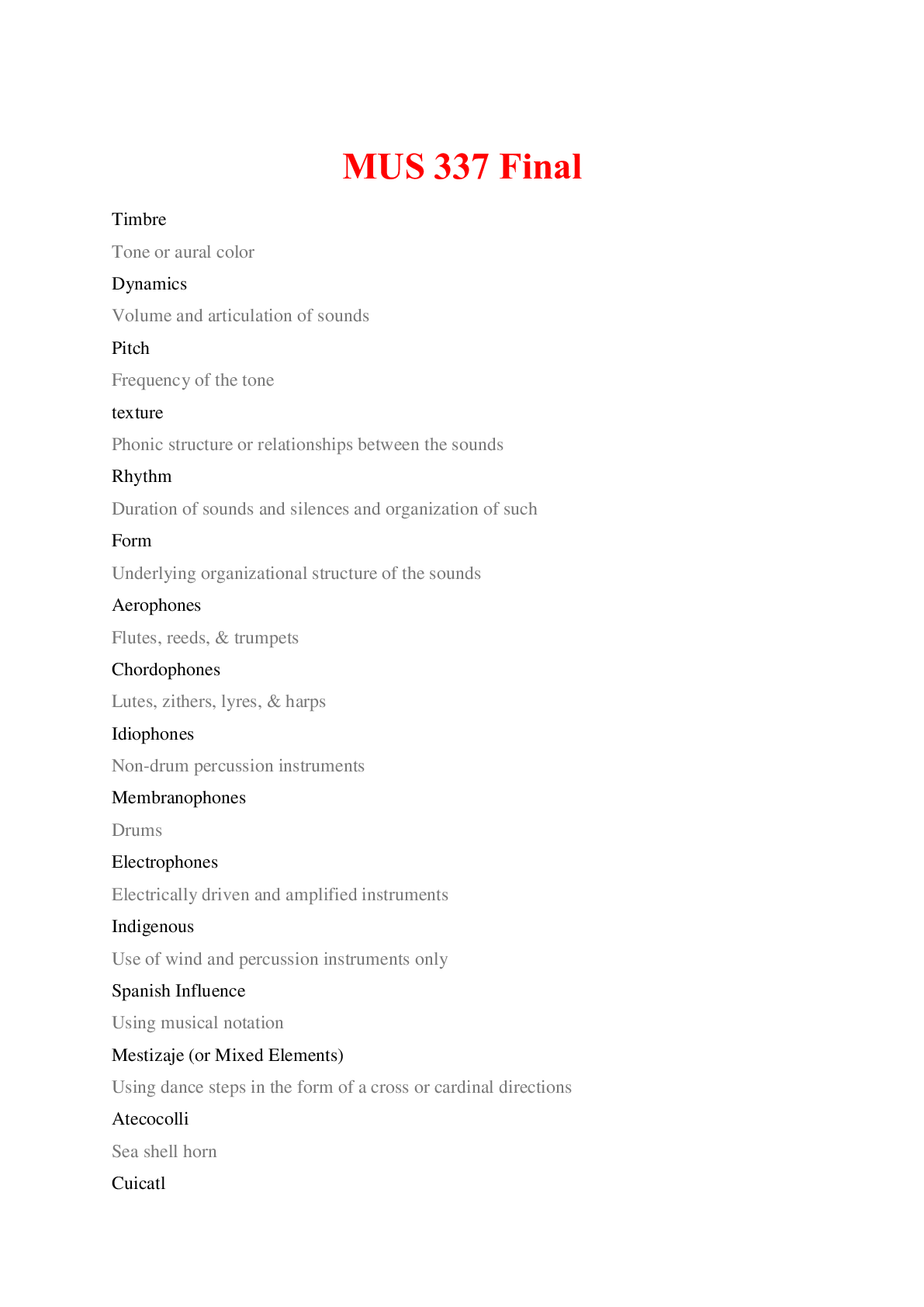







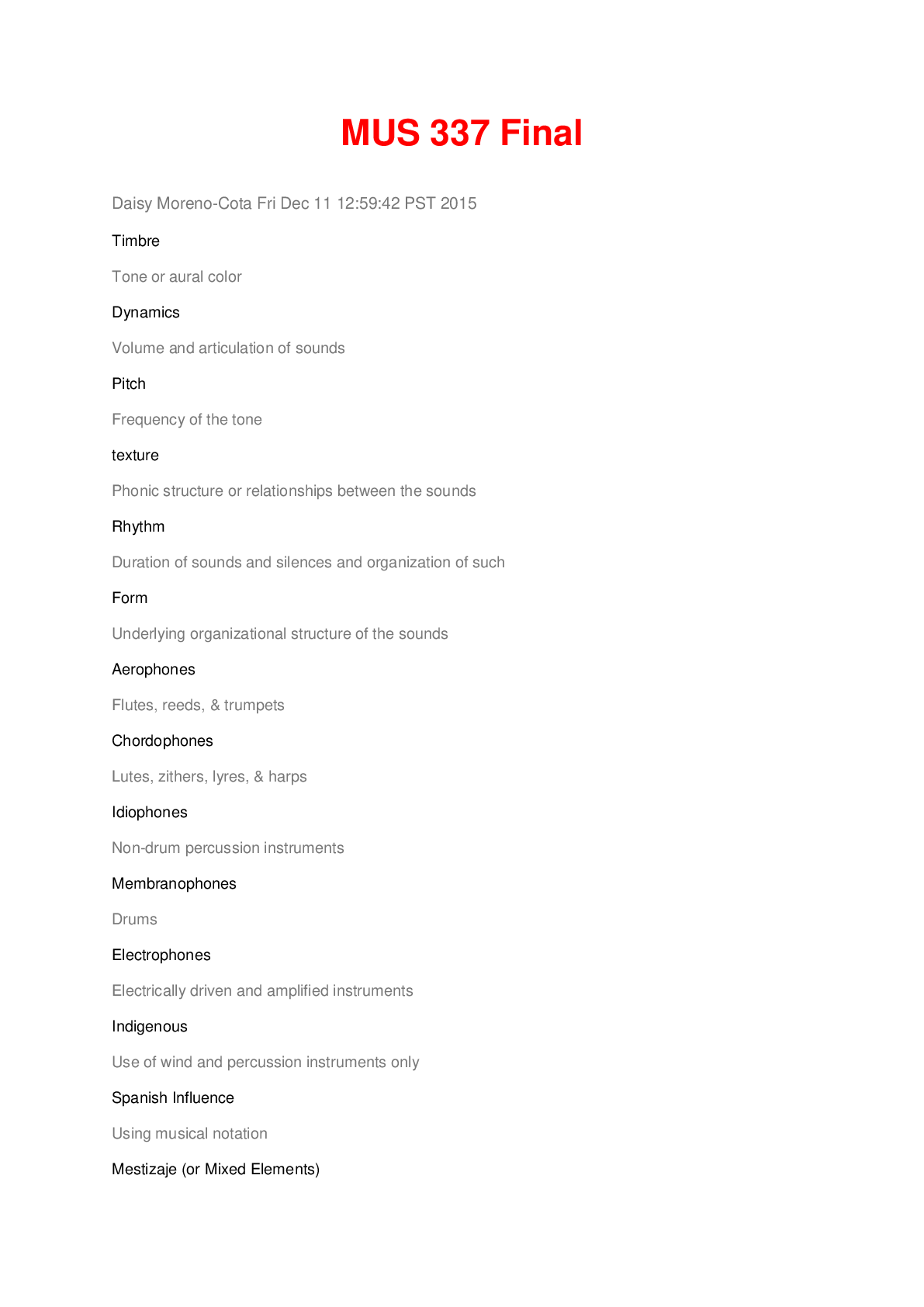




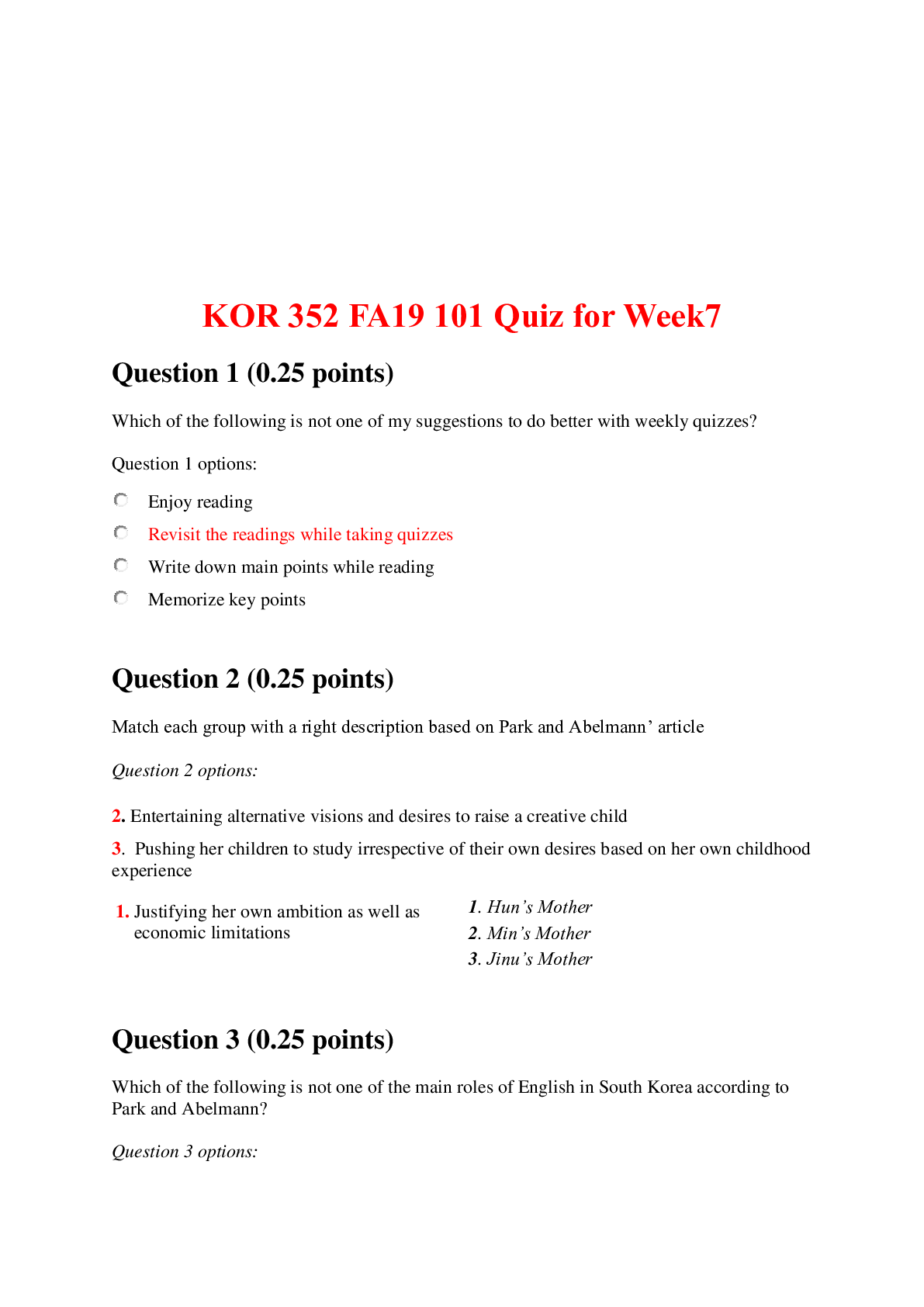

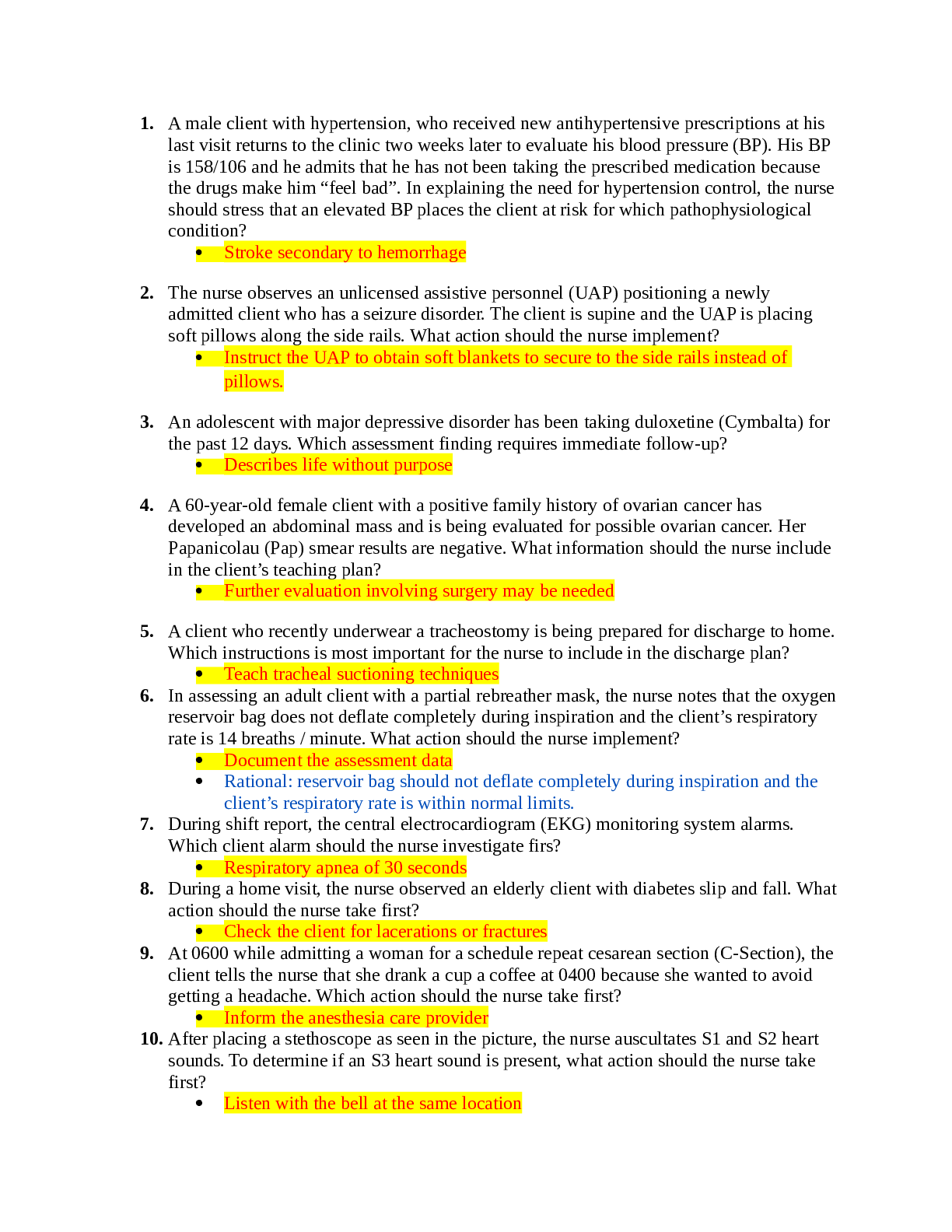

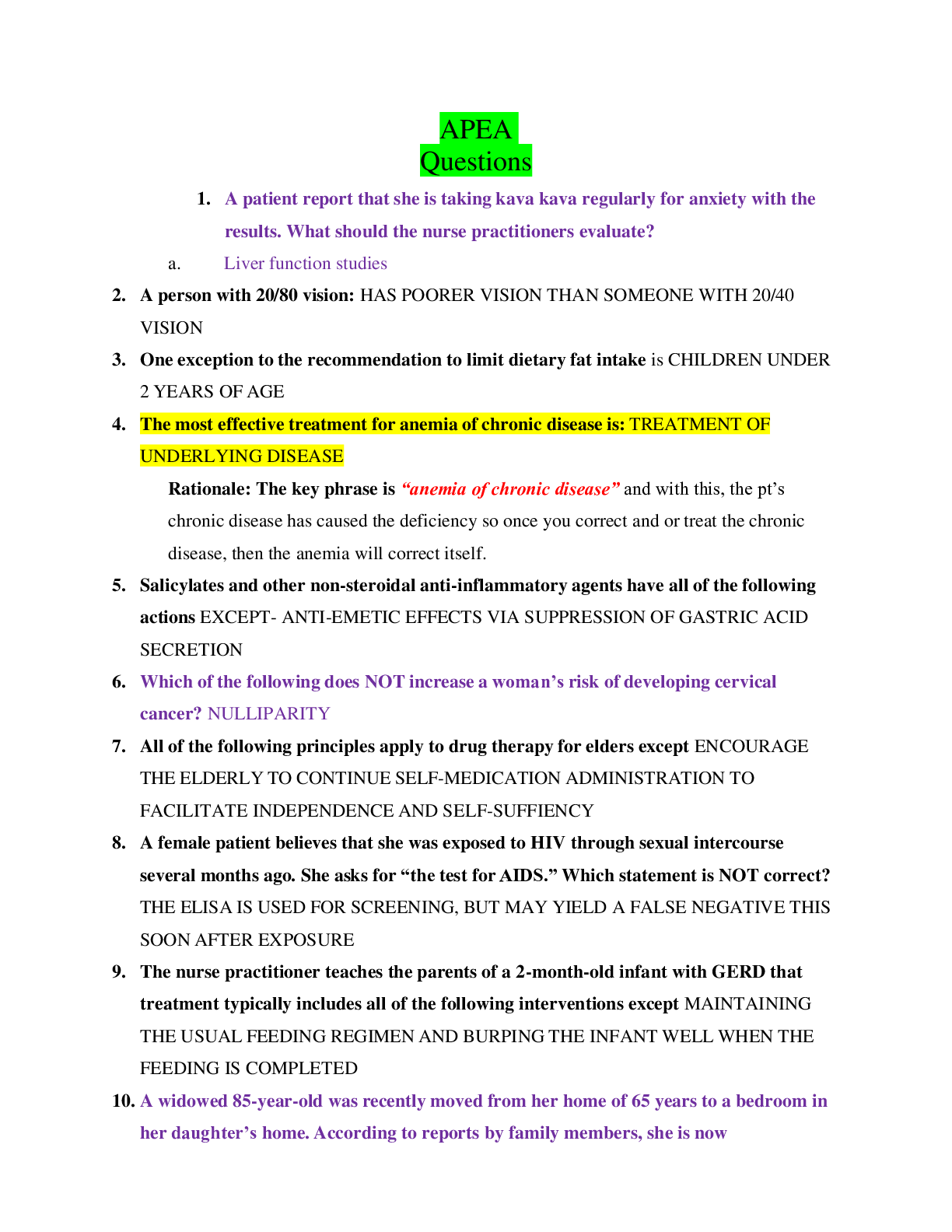



.png)

.png)

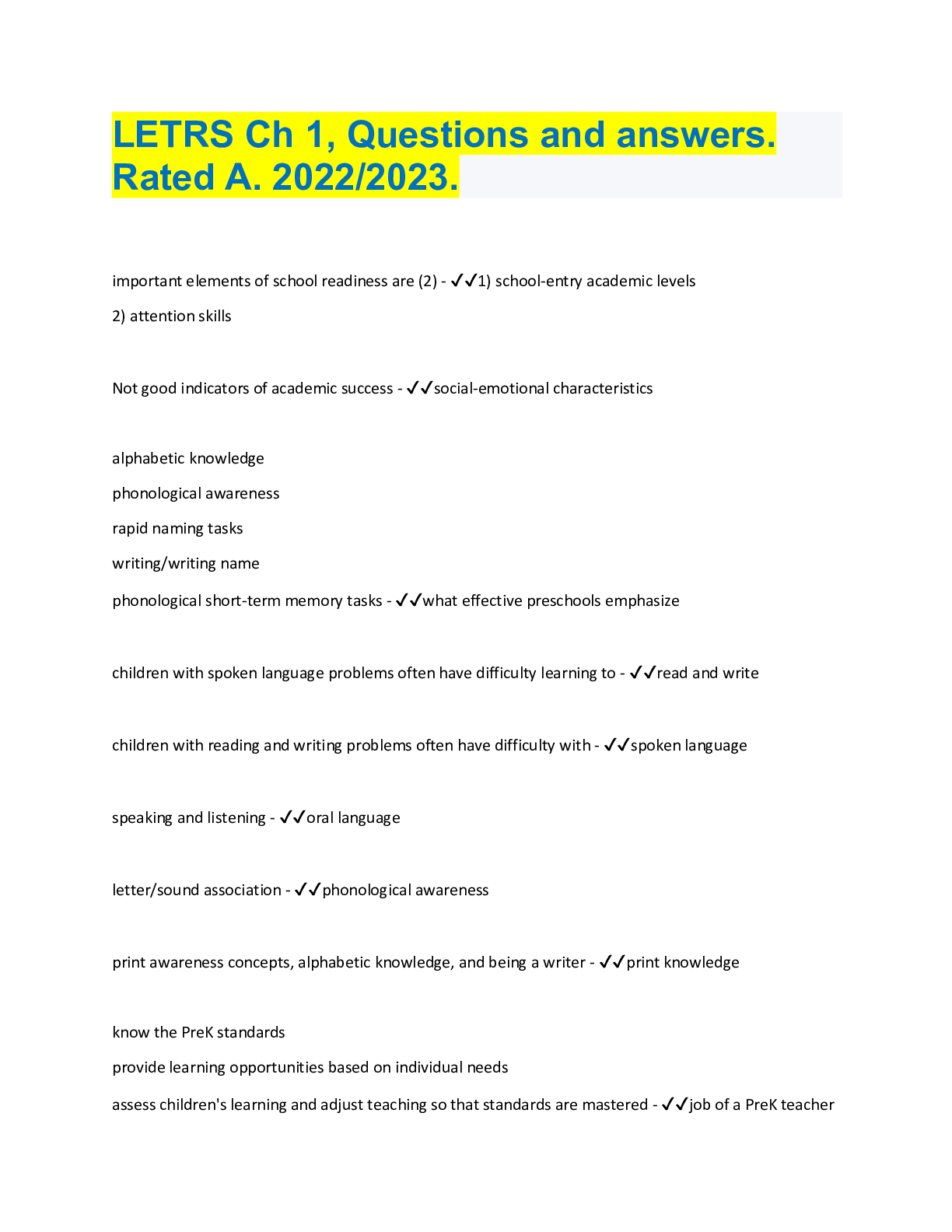
.png)
.png)

.png)
